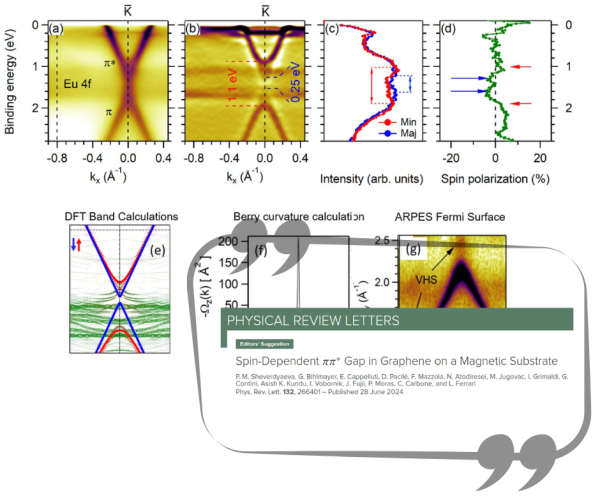The hybridization of Dirac cones with the 4f states of Eu removes the spin degeneracy of the π state, inducing the opening of a wide spin-dependent band gap at the Dirac point and creating a finite Berry curvature across the gap.
The article demonstrates that in the graphene/Eu/Ni heterostructure, the breaking of time-reversal symmetry induced by magnetic ordering paves the way for the emergence of exotic transport phenomena, such as the anomalous Hall effect. The strong electronic doping of the system due to the presence of Eu brings a van Hove singularity in graphene very close to the Fermi level, which interacts with the spin-polarized valence states of Eu and becomes spin-polarized itself.
Our ARPES measurements and many-body model reveal the presence of a kink and a satellite feature due to electron-phonon coupling and the strong doping of the system caused by the Eu atoms.
These results pave the way for transforming graphene into a spin field-effect transistor, a spin valve, or a spin-transfer torque device, as well as realizing unconventional superconductivity, quantum phases, or topological insulator states in graphene.
This work is a collaboration of CNR-ISM with CNR-IOM, University of Calabria, Forschungszentrum Jülich and JARA, Ca’ Foscari University of Venice, Elettra Sincrotrone, and ICTP.
Friday, 19 July 2024 15:07
Spin-Dependent ππ* Gap in Graphene on a Magnetic Substrate - A new paper
 a) Spin-integrated ARPES of graphene/Eu/Ni. (b) Second derivative of the map (a). (c) Minority-spin (red) and majority-spin (blue) EDCs acquired at the center of the Dirac cone. (d) Spin polarization corresponding to the spectrum (c). (e) Spin-resolved DFT band structure calculation. (f) Berry curvature calculation. (g) Experimental Fermi surface.
a) Spin-integrated ARPES of graphene/Eu/Ni. (b) Second derivative of the map (a). (c) Minority-spin (red) and majority-spin (blue) EDCs acquired at the center of the Dirac cone. (d) Spin polarization corresponding to the spectrum (c). (e) Spin-resolved DFT band structure calculation. (f) Berry curvature calculation. (g) Experimental Fermi surface.
A study on the electronic properties of the Graphene/Ni(111) system intercalated with a monolayer of Eu has been conducted by a group of CNR-ISM researchers and published in Physical Review Letters, selected as an Editor’s Suggestion.
This system allows for the induction of spin polarization in graphene while simultaneously maintaining its electronic characteristics nearly unchanged. Angle-resolved and spin-resolved photoemission spectroscopy (ARPES) measurements, combined with DFT calculations, show that the system retains the linear dispersion of the graphene Dirac cones, despite the presence of the strongly interacting Ni substrate.
Published in
Publications

 English (UK)
English (UK)  Italiano (Italia)
Italiano (Italia)